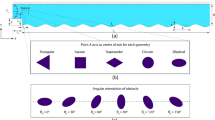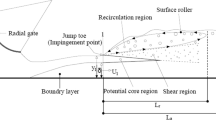Abstract
The geometry of a downstream obstacle is one of the major parameters affecting the stability range of circular hydraulic jumps and, yet, it has not been adequately addressed by researchers. The present study investigates the effects of the downstream obstacle geometry and the parameters like the flow rate, the jet diameter, and the downstream obstacle height on the stability range of circular hydraulic jumps. Its findings indicate that an increase in the fluid jet diameter leads to the narrowing of the stability range of circular jumps. In addition, an increase in the downstream obstacle height produces a reduction of the hydraulic jump radius and its stability range. The results also show that in the presence of a square downstream obstacle the stability range of circular jumps is less than that in the case of a triangular downstream obstacle and greater than in the case of a circular downstream obstacle.








Similar content being viewed by others
Notes
In classifying the types of flows basing on the Froude number, the critical flow is the flow with a Froude number equal to one. The Froude number (Fr = \({v}\)/c) is the fluid velocity \({v}\) divided by the wave velocity in shallow water c = \(\sqrt {gy} \). If the fluid velocity is higher than the wave velocity, the flow is supercritical and it will carry the wave. So, the wave cannot move upstream. In this case, any phenomenon that occurs in the stream affects only its downstream. On the other hand, if the fluid velocity is lower than the wave velocity, the flow is subcritical and the wave can move upstream. In this case, any phenomenon that occurs in the flow also affects its upstream.
REFERENCES
C. Avedisian and Z. Zhao, “The circular hydraulic jump in low gravity,” Proc. Roy. Soc. London. Ser. A 456, 2127–2151 (2000).
R. Kate, P. Das, and S. Chakraborty, “An investigation on non-circular hydraulic jumps formed due to obliquely impinging circular fluid jets,” Exp. Therm. Fluid Sci. 32, 1429–1439 (2008).
Lord Rayleigh, “On the theory of long waves and bores,” Proc. Roy. Soc. London. Ser. A. 90(619), 324–328 (1914).
G. Birkhoff and E. Zarantonello, Jets, Wakes, and Cavities (Academic Press, New York, 1957).
E. Watson, “The radial spread of a fluid jet over a horizontal plane,” J. Fluid Mech. 20, 481-499 (1964).
A. Craik, R. Latham, M. Fawkes, and P. Gribbon, “The circular hydraulic jump,” J. Fluid Mech. 112, 347–362 (1981).
M. Errico, A study of the interaction of fluid jets with solid surfaces (University of California, San Diego, 1986).
X. Liu and J. H. Lienhard, “The hydraulic jump in circular jet impingement and in other thin fluid films,” Exp. Fluids. 15, 108–116 (1993).
J. W. Bush and J. M. Aristoff, “The influence of surface tension on the circular hydraulic jump,” J. Fluid Mech. 489, 229–238 (2003).
C. Ellegaard, A. E. Hansen, A. Haaning, and T. Bohr, “Experimental results on flow separation and transitions in the circular hydraulic jump,” PhysicaScripta105 (1996).
J. W. Bush, J. M. Aristoff, and A. Hosoi, “An experimental investigation of the stability of the circular hydraulic jump,” J. Fluid Mech. 558, 33–52 (2006).
T. Bohr, P. Dimon, and V. Putkaradze, “Shallow-water approach to the circular hydraulic jump,” J. Fluid Mech. 254, 635–648 (1993).
T. Bohr, V. Putkaradze, and S. Watanabe, “Averaging theory for the structure of hydraulic jumps and separation in laminar free-surface flows,” Phys. Rev. Lett. 79, 1038 (1997).
F. Higuera, “The hydraulic jump in a viscous laminar flow,” J. Fluid Mech. 274, 69–92 (1994).
K. Yokoi and F. Xiao, “A numerical study of the transition in the circular hydraulic jump,” Phys. Lett. A257, 153–157 (1999).
K. Yokoi and F. Xiao, “Mechanism of structure formation in circular hydraulic jumps: Numerical studies of strongly deformed free-surface shallow flows,” Phys. D: Nonlinear Phenomena161, 202–219 (2002).
V. Ferreira, M. Tome, N. Mangiavacchi, A. Castelo, J. Cuminato, A. Fortuna, and S. Mckee, “High-order upwinding and the hydraulic jump,” Int. J. Numer. Methods Fluids39, 549–583 (2002).
S. Watanabe, V. Putkaradze, and T. Bohr, “Integral methods for shallow free-surface flows with separation,” J. Fluid Mech. 480, 233–265 (2003).
A. K. Ray and J. K. Bhattacharjee, “Standing and travelling waves in the shallow-water circular hydraulic jump,” Phys. Lett. A 371, 241–248 (2007).
J. Mikielewicz and D. Mikielewicz, “A simple dissipation model of circular hydraulic jump,” Int. J. Heat Mass Transfer52, 17–21 (2009).
M. Passandideh-Fard, A. R. Teymourtash, and M. Khavari, “Numerical study of circular hydraulic jump using volume-of-fluid method,” J. Fluids Eng. 133, 011401 (2011).
C. W. Hirt and B. D. Nichols, “Volume of fluid (VOF) method for the dynamics of free boundaries,” J. Comput. Phys. 39, 201–225 (1981).
C. Ellegaard, A. E. Hansen, A. Haaning, K. Hansen, A. Marcussen, T. Bohr, J. L. Hansen, and S. Watanabe, “Cover illustration: Polygonal hydraulic jumps,” Nonlinearity12, 1 (1999).
A. R. Teymourtash and M. Mokhlesi, “Experimental investigation of stationary and rotational structures in non-circular hydraulic jumps,” J. Fluid Mech.762, 344–360 (2015).
A. R. Kasimov, “A stationary circular hydraulic jump, the limits of its existence and its gasdynamic analogue,” J. Fluid Mech. 601, 189–198 (2008).
E. A. Martens, S. Watanabe, and T. Bohr, “Model for polygonal hydraulic jumps,” Phys. Rev. E 85, 036316 (2012).
Author information
Authors and Affiliations
Corresponding author
Ethics declarations
The Authors declare no potential conflicts of interest with respect to the research, authorship, and/or publication of this article.
Rights and permissions
About this article
Cite this article
Asadi, A., Jafarian, S. & Teymourtash, A. Experimental Study of Stable Circular Hydraulic Jumps. Fluid Dyn 55, 477–487 (2020). https://doi.org/10.1134/S0015462820040035
Received:
Revised:
Accepted:
Published:
Issue Date:
DOI: https://doi.org/10.1134/S0015462820040035




